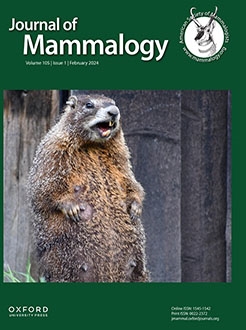Latrine sites are used as areas for the deposition of scent-containing excretions and play important roles in intraspecific olfactory communication, territoriality, sexual attraction, and defense behaviors of many mammals. African clawless otters (Aonyx capensis) likely use latrine sites as primary areas for scent marking and scent communication but no studies to date have investigated their potential role or site selection. We assessed latrine site selection at 2 spatial scales (micro- and macroscale) and recorded behaviors via camera trap recordings. Thirty-eight latrine sites were identified and assessed at 2 locations in Mtunzini on the north coast of KwaZulu-Natal, South Africa (uMlalazi Nature Reserve and Zini Fish Farm) during the months of August to November 2021. Latrine sites were identified through several intensive surveys, while we characterized nonselected sites through a systematic sampling approach. Latrine and control sites were inventoried along a 52-m buffer around all water bodies in both study areas. At each site we measured a series of potential environmental predictors, including horizontal and vertical vegetation cover, surface slope, and averaged wind speeds for days classified as relatively wind-still and relatively windy. To assess the relative role of various environmental predictors, we used a binomial generalized linear model resource selection function to model both spatial scales of latrine site selection. The majority of latrine sites were located at the ecotone between 2 vegetation units or between a vegetation unit and a water source. At a macroscale, latrine sites were associated with areas containing little vegetative substrate cover and minimal canopy cover. The top-ranked models at the microscale also indicated that latrine sites were characterized as occurring in open areas with less canopy and horizontal cover and on flatter areas that are relatively protected against wind. The most common behaviors recorded at 3 latrine sites were the “jiggle dance” (42%) and sniffing (29%). We hypothesize that otters evaluate numerous environmental parameters to enhance the functionality of latrine sites. For example, sites with little vegetative cover may increase the conspicuousness of latrines to conspecifics, while areas exposed to less wind likely aid in the retention of scent. Ongoing research is characterizing the behaviors of otters around latrines and chemical signatures of latrine sites in an effort to facilitate interpretation of their social function to African clawless otters.
How to translate text using browser tools
17 January 2024
Latrine site selection by African clawless otters, Aonyx capensis, and their behavior during latrine visitations
Stephanie G. Nicolaides,
Theodorus H.C. Mostert,
Trevor McIntyre
SIGN IN TO VIEW ARTICLE

Journal of Mammalogy
Vol. 105 • No. 1
February 2024
Vol. 105 • No. 1
February 2024
Mustelidae
olfactory communication
scent marking
small carnivore
territoriality





